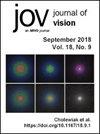Foveal neural adaptation to optically induced contrast reduction.
IF 2
4区 心理学
Q2 OPHTHALMOLOGY
引用次数: 0
Abstract
Contrast processing is suggested to interact with eye growth and myopia development. A novel contrast-reducing myopia control lens design decreases image contrast and was shown to slow myopia progression. Limited insights exist regarding neural visual processing following adaptation to image contrast reduction. This study investigated foveal neural contrast sensitivity in 29 young adults following a 30-minute adaptation to scattering using a Bangerter occlusion foil 0.8, +0.5-diopter defocus, and a clear lens control condition. Neural contrast sensitivity at its peak sensitivity of 6 cycles per degree was assessed before and after adaptation to the lens conditions, employing a unique interferometric system. Pre-adaptation measurements were averaged from six replicates and post-adaptation measurements by the first and last three of six replicates. The change in neural contrast sensitivity was largest for scattering across the first and last three post-adaptation measurements (+0.05 ± 0.01 logCS and +0.04 ± 0.01 logCS, respectively) compared with control and defocus (all +0.03 ± 0.01 logCS). For scattering, the observed increase of neural contrast sensitivity within the first three measurements differed significantly from the pre-adaptation baseline (p = 0.04) and was significantly higher compared with the control condition (p = 0.04). The sensitivity increases in the control and defocus conditions were not significant (all p > 0.05). As the adaptation effect diminished, no significant differences were found from baseline or between the conditions in the last three measurements (all p > 0.05). When post-adaptation neural contrast sensitivities were clustered into 25-second sequences, a significant effect was observed between the conditions, with only a significant relevant effect between control and scattering at 25 seconds (p = 0.04) and no further significant effects (all p > 0.05). The alteration in neural contrast sensitivity at peak sensitivity was most pronounced following adaptation to the scattering condition compared with defocus and control, suggesting that induced scattering might be considered for myopia control.眼窝神经对光学诱导的对比度降低的适应。
对比度处理被认为与眼睛的生长和近视的发展相互影响。一种新颖的降低对比度的近视控制镜片设计可降低图像对比度,并能减缓近视的发展。关于适应图像对比度降低后的神经视觉处理,目前的研究还很有限。本研究调查了 29 名年轻成年人在使用 Bangerter 遮盖箔 0.8、+0.5-diopter 散焦和透明镜片控制条件下进行 30 分钟散焦适应后的眼窝神经对比敏感度。采用独特的干涉测量系统,在适应镜片条件之前和之后,评估了神经对比敏感度在每度 6 个周期的峰值敏感度。适应前的测量结果取六个重复样本的平均值,适应后的测量结果取六个重复样本中前三个和后三个的平均值。与对照组和散焦组(均为 +0.03 ± 0.01 logCS)相比,散射组神经对比敏感度在适应后的前三次和后三次测量中变化最大(分别为 +0.05 ± 0.01 logCS 和 +0.04 ± 0.01 logCS)。对于散焦,在前三次测量中观察到的神经对比灵敏度的增加与适应前的基线有显著差异(p = 0.04),并且与对照组相比显著更高(p = 0.04)。在对照和散焦条件下,灵敏度的增加并不显著(所有 p > 0.05)。随着适应效应的减弱,最后三次测量结果与基线或不同条件下的测量结果均无显著差异(均 p > 0.05)。当将适应后的神经对比敏感度集中到 25 秒序列时,观察到不同条件之间存在显著效应,只有在 25 秒时对照组和散射组之间存在显著相关效应(p = 0.04),并且没有进一步的显著效应(所有 p > 0.05)。与散焦和对照组相比,适应散射条件后神经对比敏感度峰值的改变最为明显,这表明可考虑将诱导散射用于近视控制。
本文章由计算机程序翻译,如有差异,请以英文原文为准。
求助全文
约1分钟内获得全文
求助全文
来源期刊

Journal of Vision
医学-眼科学
CiteScore
2.90
自引率
5.60%
发文量
218
审稿时长
3-6 weeks
期刊介绍:
Exploring all aspects of biological visual function, including spatial vision, perception,
low vision, color vision and more, spanning the fields of neuroscience, psychology and psychophysics.
 求助内容:
求助内容: 应助结果提醒方式:
应助结果提醒方式:


